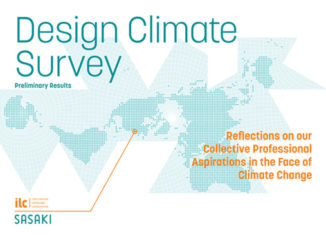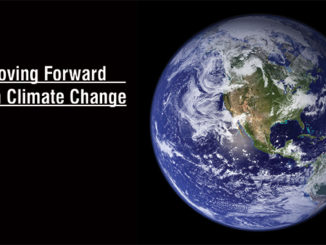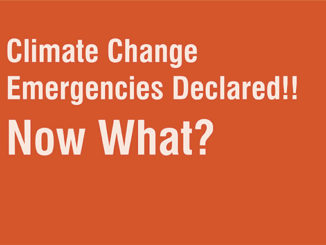On October 20th, 2017 at the American Society of Landscape Architecture (ASLA) Annual Conference in Los Angeles, CA – Martha Schwartz, Principal of Martha Schwartz Partners and Pamela Conrad, Associate with CMG Landscape Architecture based out of San Francisco, CA urged the landscape architecture community to actively contribute to reversing global warming. Conrad also joined a panel of global experts focused on “Designing for the Earth” earlier that week at the World Design Summit in Montreal, Canada.
Article by Pamela Conrad, CMG Landscape Architecture:
What can we as Landscape Architects do to reverse global warming? It’s a daunting task for sure, but one that we must both engage and contribute to its solution.
As landscape architects, we are uniquely qualified to process and synthesize complex challenges that yield sustainable, world-changing solutions. We have a significant role to play in the fight against climate change – both in adapting landscapes from the effects of global warming but also by mitigating, or designing against, the causes of global warming.
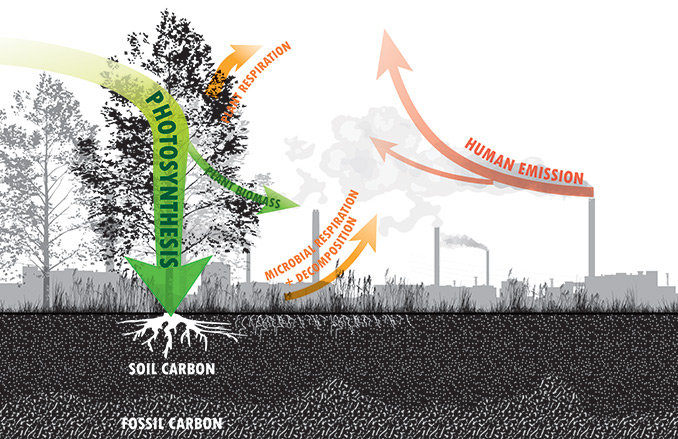
So, what can we do?
‘Landscape’ is what sets us apart from architecture and it is that difference which makes all the difference in what we’re trying to accomplish. Landscapes are traditionally planted so they possess the power to sequester carbon where architecture cannot. That being said, can Landscape Architects do better than carbon neutral? Can we instead strive beyond neutrality to do “net good” and contribute to the fight against climate change? The answer is yes, but if we want to join this global initiative, we must measure our contributions.
To improve the impact of our projects on the planet, we need to better understand their landscape carbon footprints. Carbon calculators exist for architecture such as Athena and GaBi, but none are publicly available for landscape architecture. Our work is distinct enough that we need a specific and custom carbon calculator for our profession in order to track carbon footprints and set collective goals.
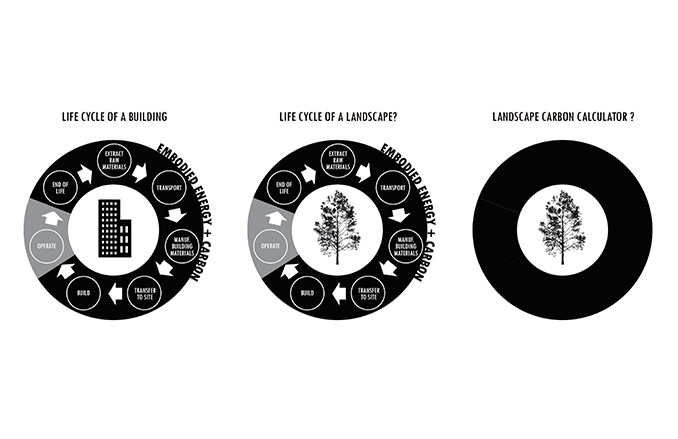
Without finding the tool I needed to understand the carbon footprint of my projects, I created a simple carbon calculator. It uses a 3-part structure that takes into account sources (embodied carbon of materials/construction – carbon emitted for the project), sinks (such as trees, plants and wetlands – where the carbon is stored), and the costs (carbon emitted through grading, ongoing maintenance, etc.). Then by adding the sources and costs together and subtracting the sinks you arrive at a landscape carbon footprint* for your project. (*Disclaimer – I am not a scientist, nor a life cycle metric expert – just a landscape architect wanting to understand the impact of my projects on the world. Even the best carbon calculators give a range of +/-25% accuracy, so bear that in mind.)
After going through the process of creating this calculator and then running three different projects through it, I gleaned the following:
- High carbon outputs are from highly processed materials (plastics, steel, concrete)
- Natural elements have less embodied carbon – if wood, use reclaimed, or sustainably harvested
- Use recycled materials where possible (steel, aluminum)
- Plant as many trees and plants as you can – incorporate forests at any scale
- Create other carbon sinks
- Coastal wetlands, such as mangroves, tidal marshes, and seagrasses can sequester up to five times the amount than tropical rain forests. (Drawdown, P. Hawken, 2017)
- Because bamboo is a grass, it can store carbon in the soil for thousands of years. (Drawdown, P. Hawken, 2017)
- Green roofs can sequester carbon and also reduce the energy needs in the floor below by 50% (Drawdown, P. Hawken, 2017)
- Use the maximum amount of cementitious substitutions (slag, flyash, silica fume) in concrete
- Get creative to reduce materials – limit piping by using natural swales and permeable paving
- Overgrading = excessive release of CO2. Keep your carbon in the soil. You can learn more about this by studying regenerative farming practices.
- On urban projects, “greening” is a challenge. Think about vertical vines/gardens or rooftops.
- We need product manufacturers to provide the carbon footprint of their products so we can incorporate this into the overall project carbon footprint.
By making a few design or material changes, we can see drastic reductions in the overall carbon footprint of a project and the time needed to offset the carbon emitted during construction. On our park project, a few simple moves could have eliminated 200 metric tons of carbon from being emitted into the atmosphere. And perhaps more significantly, on the plaza site, just by increasing the planting area from 5% to 10%, we could have reduced the time it takes to offset its emitted carbon by over 100 years.
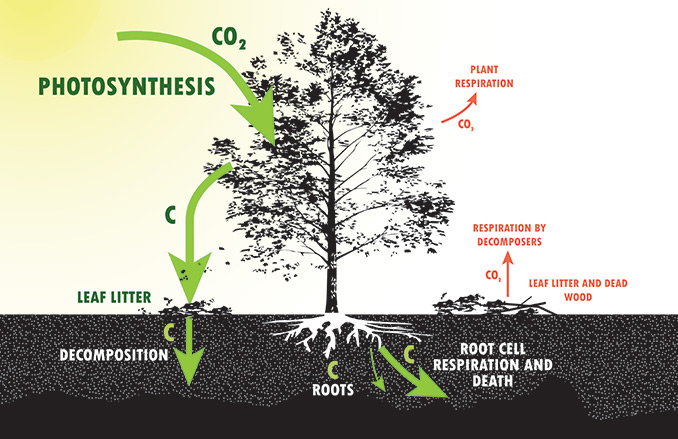
This exercise made it clear that landscape architects impact the environment beyond the sensory experience. With a more refined tool and constant carbon tracking through the life of a project, just like a cost estimate, we can greatly reduce the carbon footprint of our projects. Not only can we decrease the amount of carbon emitted through our work, but the sooner we offset our own footprint, the sooner our projects can begin sequestering additional greenhouse gases from the atmosphere and contribute to reversing global warming.
To date, the landscape carbon calculator is a beta version that needs testing. The goal is to refine this tool and make it accessible for landscape architects everywhere. Once it becomes available, we can then begin setting goals for ourselves as a profession to join our place in this global fight.
To find out more on how you can contribute to the “Landscape Carbon Initiative” or to join the forthcoming ASLA Professional Practice Network on Climate Change, email pconrad@cmgsite.com.
References: “Drawdown”, Paul Hawken, 2017.
Images & Text by Pamela Conrad
About the Author
Pamela Conrad PLA, LEED AP
ASSOCIATE – CMG Landscape Architecture
Pamela has fourteen years of experience designing and managing domestic and international projects. She brings an ecologically sensitive approach to her work, and focuses on transforming marginalized urban spaces into public parks and the integration and restoration of ecological systems into the urban interface. Growing up on a farm, she connected with the land at a very early age and her appreciation of the preservation of open space continues to grow as she sees the world rapidly developing. Today, in the face of climate change, Pamela is focusing on designing resilient communities, tactics on how to adapt to imminent sea level rise, and incorporating climate change mitigation strategies into everyday design practices.
EDUCATION
Master of Landscape Architecture; California State Polytechnic University
ITALart Santa Chiara Study Program, Castiglion Fiorentino, Tuscany, Italy; Landscape Architecture Study Abroad Program
Bachelor of Science in Plant Science, emphasis in Landscape Design; University of Missouri

